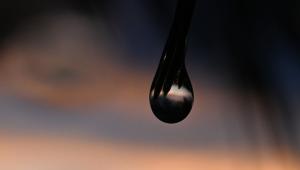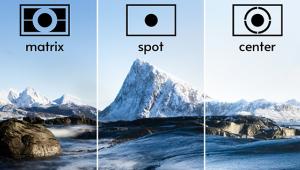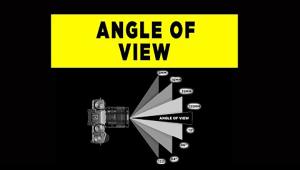LaCie 324i LCD Display: A Top Display For Serious Photographers
If you are a serious digital photographer you probably have a good D-SLR camera. And you expect it will capture sharp, finely focused, high-quality photographic images. It follows that the display you choose should be capable of reproducing all the attributes and qualities your camera has recorded. Most of the displays sold with computers in box stores, however, are not much better at reproducing photographs than the old-type big and heavy CRTs we had back in the mid-1990s.
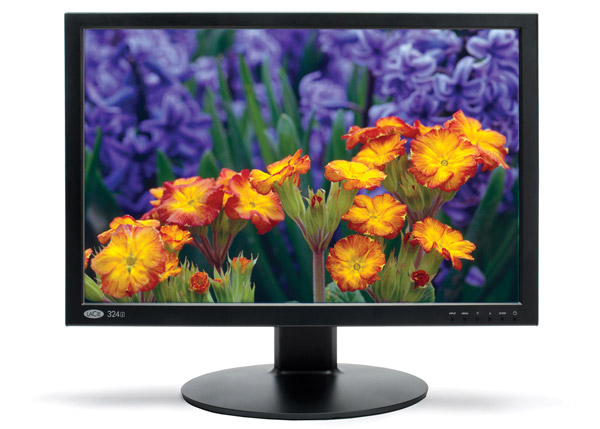
Photos courtesy of LaCie
Yes, the new ones are lighter, and cheaper, but their color range is just sRGB, only two-thirds of what a D-SLR captures, and the resolution is no better than a 21” CRT monitor from 1995.
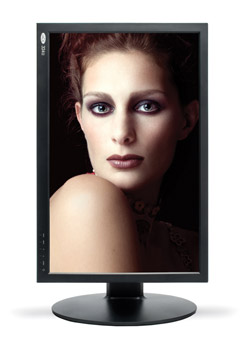
Today, the best LCD displays for photographic computing are expensive, but that is mainly because a dollar today won’t buy what it did in 1995. Regardless, I bought one of the best for my lab recently, a LaCie 324i, which currently has a $1099 price tag, but to me the price is more than just a luxury, it’s a necessary part of my work. The LaCie 324i is a 24” P-IPS LCD display with 1920x1200 resolution. It is a wide color range display that reproduces 98 percent of Adobe RGB color and, with 10-bit gamma correction, renders tones with fine smoothness.
One of the features of the 324i that has been lacking in any LCD display I have worked with lately is its adjustable backlight control. This is extremely valuable when adjusting the display brightness and contrast to achieve a 90.0 CD/m2 white luminance, made to match paper white without losing optimum color reproduction—once the display is calibrated and profiled. The result is that the LaCie reproduces digital photographs with completely accurate color and tone, which makes editing changes easy to see and yields a perfectly refined photograph. This display will do your camera and your photographs justice by reproducing all the values that are in the images, because in the end you can only make your finished digital photographs as good as what you can see on your computer monitor.

All Photos © David B. Brooks
Part of the attractiveness of this unit is the build. In the last two or three years, consumer computer displays in box stores are much lighter, with plastic stands and supports that provide little adjustment. That reduces shipping weight, allowing for cheaper store prices. The LaCie 324i comes with a sturdy metal stand that has a wide range of adjustments, including being able to rotate the display to use it in portrait mode, and it weighs in at almost 25 lbs. In addition, many home/office displays have shiny screen surfaces that are easier to keep clean but also reflect areas surrounding the display. The LaCie 324i has a matte, low reflectance screen surface, so there’s much less of a problem with reflecting room light and objects.
Today, few LCD displays have a matching sized screen hood to block unwanted light from affecting the image on screen, but it is an option with the LaCie. The 324i also has a full range of connections for video input, including DVI, HDMI, Display Port, as well as Component RCA plug connectors. There is also a powered USB connection built in with one input and two USB output connectors. The display is also connector setup for audio with a stereo input and output connector. Finally, for calibration and profiling, LaCie offers a complete software option as well as their own colorimeter. But unlike some other brands, the LaCie 324i is compatible with all of the standard display color management systems. So if you have a recent wide color range colorimeter, you can use it with the LaCie 324i successfully.

Setting Up The LaCie 324i
Unpacking and installing the LaCie 324i was a simple and easy task, and is well explained in the quick version of instructions. I had it connected and my computer booted up to present a more or less normal interface on the screen. So I just let it run and did other things before adjusting calibration and profiling the display to be sure it was fully warmed up.
I did have a new adjustment challenge, as it is the first recent display I have used that has a backlight adjustment; most today just have a brightness and contrast adjustment. Although I have continually asked the question of what is the best strategy for manually adjusting an LCD display to achieve a brightness that matches paper white, none of the experts at the companies that have software for doing this automatically with an LCD connected to the computer for internal adjustment have ever provided any helpful information. So, I have just proceeded with my own theory and experience.
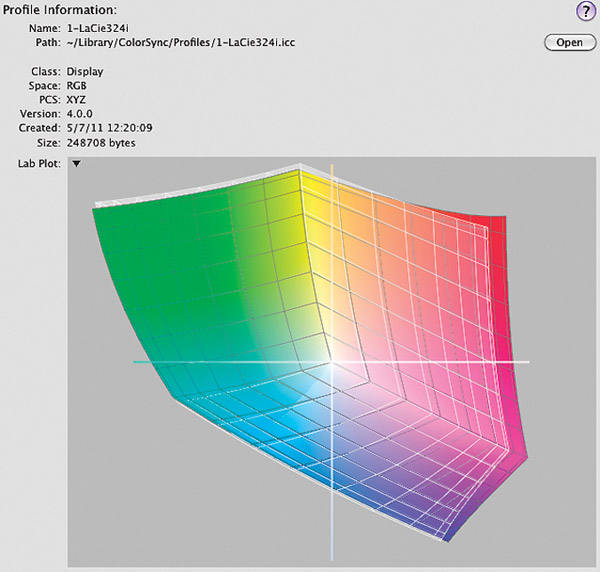
LCD displays are digital devices, so I assume there is a similarity to brightness and contrast adjustments to those in image-editing applications. That brightness moves the tonal midpoint up or down in the scale of values to make an image look lighter or darker. If the midpoint is set in the middle of the range, then the spaces taken up by a 20-step tablet of gray tones will be even on both sides of the midpoint. If the midpoint is moved up or down to increase or lessen brightness, the tonal spaces on each side of the midpoint do not match in size. In other words, the light or dark values are either expanded or crammed tighter together, distorted and not linear. So I always set a manual brightness adjustment of a display in the middle of its range, 50 percent, if that is the scale. With the contrast adjustment, the bottom of the scale remains just a little above zero for black, and adjustment of the manual LCD control raises or lowers the maximum white value (luminance). So to get the white luminance to my desired 90.0 CD/m2, I usually lower the LCD contrast adjustment until my display calibration and profiling software reads that white luminance level with the colorimeter.
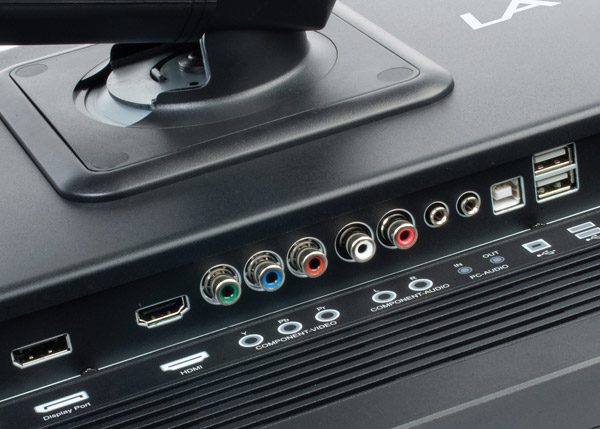
Photos courtesy of LaCie
With the LaCie 324i there is a third adjustment for backlight level that will affect the white luminance output of the display. The higher the backlight setting, the higher the white luminance reading, and conversely the lower the setting, the lower the white luminance. So I began a set of adjustments and measured, calibrated, and profiled with the backlight adjustment at zero. This did not provide an ideal-looking screen image in color and tone, and the profiling report indicated the DeltaE errors were higher than desirable. So then I tried a different adjustment set with brightness at 50 percent, backlight at 10, and Contrast at 35 percent. To get the white luminance reading with my software and colorimeter to match 90.0 CD/m2, I had to adjust contrast a bit lower. But after the third calibration and profiling the DeltaE readings were lower, indicating a good-quality profile, and my test image on screen looked ideal. At that point I was ready to do some real work with the LaCie 324i.
Currently I have been editing and adjusting raw scan files of 35mm film, some of which is quite old, so there have been some difficult images to get right. A part of this is clean-up work to remove artifacts and flaws, particularly in Kodachrome and silver black-and-white images. This work has always been a challenge, but I have found the images displayed by the LaCie 324i reveal more color variation and detail than I have seen before, and the screen size and resolution reproduced the small errors and artifacts clearly for precise repairs. I have worked with some good LCD displays recently, but the LaCie is just that much better and more refined to make my work easier and the results closer to what I find meets any realistic expectations I have to get the best out of the original film images I have in my library.
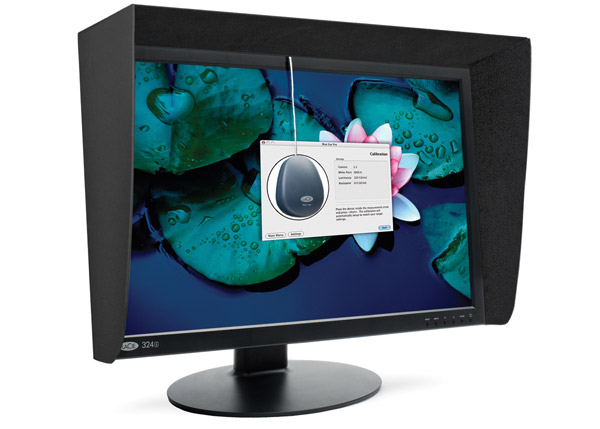
Evaluation And Recommendation
This LaCie 324i is the second LaCie LCD display I have purchased for my own use. The LaCie 320 model that is now a good number of years old still functions much as it did when new, and is now used as my second computer display to show information, dialog windows, and a browser, leaving the new 324i open as my primary image screen. Yes, LaCie LCD displays like the 324i are on the more expensive side of the price ledger for displays, but in the end it’s a moderate cost to attain really good performance and the assurance I have the best visual support needed to get the work I want to get done, done right. My budget is quite modest and usually I have to be prudent and look for ways to spend the least possible to get the job done. But not being able to see clearly and precisely what I am working on is not really economical. I can get my work done with a modest affordable computer—that element does not detract from the quality of my work. But my life is pictures, and I need to see them as well as possible. So I consider the LaCie 324i to be a good investment, and not at all extravagant.
The LaCie 324i is available for $1099 at: www.lacie.com. The display is also available online and at better photo/imaging outlets. For more information, visit www.lacie.com.






























